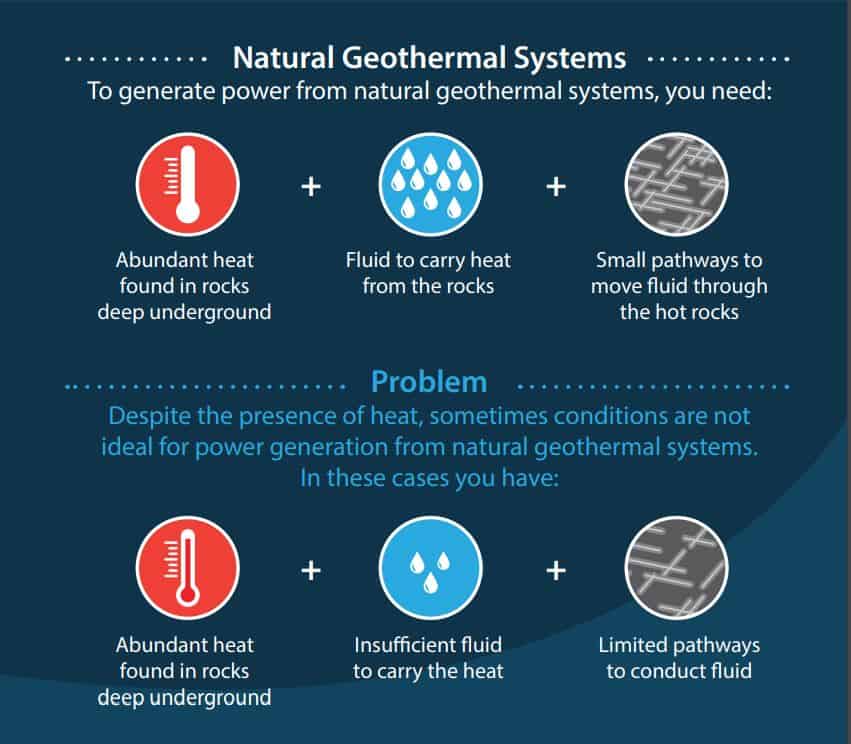As we have seen previously, natural geothermal systems are associated with very specific geologic conditions that occur in nature, like those found in the Ring of Fire. These systems provide:
- subsurface heat
- hot water or steam
- porous, permeable, and fractured rocks
Rocks in conventional systems not only serve to trap the heat, but also allow for fluids (gas or liquid) to flow. These conventional systems represent the ‘low-hanging fruit’ of geothermal energy potential and were the first to be developed.
In contrast, unconventional geothermal systems use engineered reservoirs to provide geothermal power from natural resources once considered unrecoverable because of their lack of water, depth location, or rock type. For example, sometimes we find rocks deep underground with plenty of heat, but insufficient fluid to carry the heat and limited pathways in the rock to conduct the fluid. These types of problems have been addressed by using engineering technology to create Enhanced Geothermal Systems (EGS).1U.S. Dept. of Energy, Office of Energy Efficiency & Renewable Energy. (2023, January 25). Enhanced Geothermal Systems (EGS) Infographic. https://www.energy.gov/eere/forge/enhanced-geothermal-systems.

Name the three ingredients needed to form a geothermal resource.
Incorrect
Incorrect
Correct
The goal of EGS is to recreate these same geologic conditions in locations outside of the Ring of Fire, in other words, places where the geology is not naturally conducive to hydrothermal systems. EGS taps into the earth’s deep geothermal resources that are otherwise not economical due to lack of water, location, or rock type. Aspects of the engineering, shown in the diagram below, are to inject fluids (to carry the heat) and then to fracture the rock (to increase the ability for the fluid to flow through the rock and bring the subsurface heat energy to the surface).2U.S. Dept. of Energy, Office of Energy Efficiency & Renewable Energy. (2023, January 25). Enhanced Geothermal Systems (EGS) Infographic. https://www.energy.gov/eere/forge/enhanced-geothermal-systems.3U.S. Dept. of Energy, National Renewable Energy Laboratory. (n.d.) Sedimentary and Enhanced Geothermal Systems. (accessed 2023, July 7). https://www.nrel.gov/geothermal/sedimentary-egs.html

A subsurface view of the geothermal system and accompanying power plant might look something like the drawing below, with geothermal fluid looping through the system from the injection well (cooler fluid enters the reservoir) to the production well (heated fluid brings the geothermal energy to the surface for use at the power plant).4U.S. Dept. of Energy, Office of Energy Efficiency & Renewable Energy. (n.d.). Sedimentary and Enhanced Geothermal Systems. (accessed 2023, July 5). https://www.nrel.gov/geothermal/sedimentary-egs.html

EGS offers the chance to extend use of geothermal resources to larger areas of the western United States, as well as into new geographic areas of the entire United States. There are a number of steps that must be taken to develop an EGS economic reservoir project as shown in the sequenced diagram below.
First, an exploratory well is drilled to confirm the subsurface geology. Second, a reservoir must be ‘engineered’ to allow fluid flow. An injection well is drilled and the rock is ‘stimulated’ by injecting high pressure fluids deep underground to create fractures that will enhance fluid flow. Third, a production well is drilled to allow flow of hot fluids to the surface. Fourth, the circulation of fluids is confirmed: fluid (1) is injected into the geothermal reservoir through an injection well (blue), (2) circulates through the hot rock reservoir and heats up, and (3) returns to the surface through a production well (red) at high temperature and is now ready for use at the power plant.5U.S. Dept. of Energy, Office of Energy Efficiency & Renewable Energy. (n.d.). Enhanced Geothermal Systems Technologies. (accessed 2023, July 5). https://www.energy.gov/eere/geothermal/enhanced-geothermal-systems-technologies

Many other geothermal technologies are under development, both at government laboratories and as part of industry research. Scientists and engineers must solve challenges such as lowering the cost of drilling and creating optimal fracture networks to increase the viability of these systems.